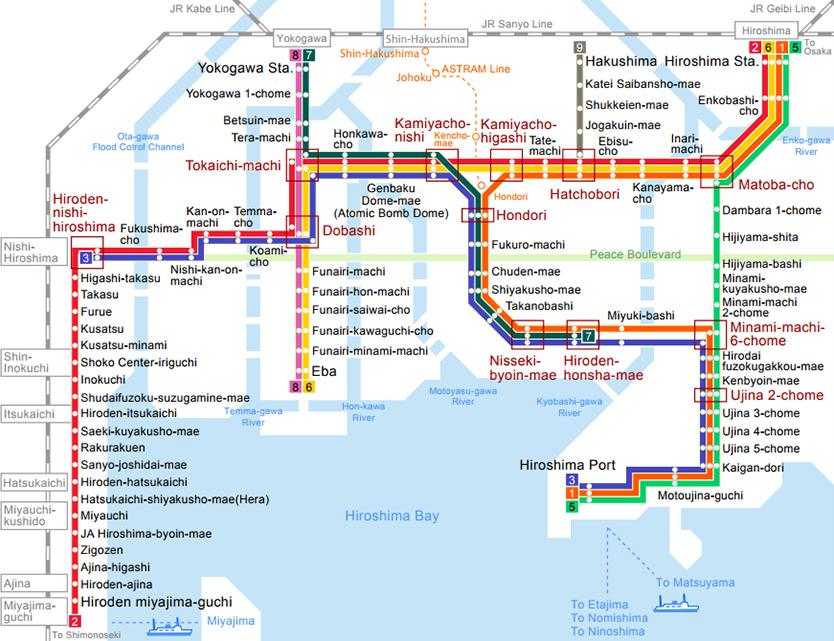Hiroshima Trams: A Comprehensive Guide to Japan's Longest Streetcar Network
- Published on : 10/06/2024
- by : Japan Experience
- Youtube
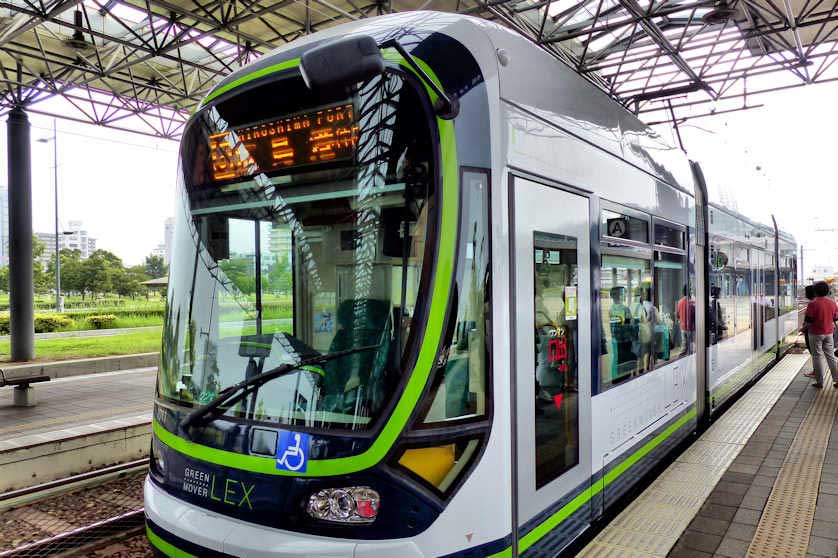
Green Mover Hiroshima tram to Hiroshima Port
Welcome to the world of Hiroshima's iconic trams, an integral part of the city's history and modern-day transportation. Hiroshima boasts the longest and most utilized streetcar network in Japan, operated by the Hiroshima Electric Railway Company, affectionately known as Hiroden. This comprehensive guide will take you on a journey through the fascinating history, intricate network, and unique features of Hiroshima's tram system. Whether you're a curious tourist or a public transport enthusiast, you'll discover why these streetcars are not just a means of getting around, but a living museum on wheels that tells the story of Hiroshima's resilience and progress.
The History and Significance of Hiroshima's Tram System
The story of Hiroshima's trams begins in the early 20th century, marking the city's modernization and growth. On June 18, 1910, the Hiroshima Electric Railway Co., Ltd. was established, and just two years later, on November 23, 1912, the first streetcars began operating in Hiroshima City. Initially, there were four main lines serving the bustling city center.
As the city expanded, so did the tram network. By 1931, all lines were operational, including the extension to Miyajima-guchi, connecting the city to the famous island shrine. The trams played a crucial role during World War II, transporting workers to munition factories and adapting to the challenging wartime conditions.
However, the most significant chapter in the trams' history came on August 6, 1945. When the atomic bomb devastated Hiroshima, 108 out of 123 streetcars were damaged or destroyed, and 185 employees lost their lives. Yet, in a testament to the city's resilience, part of the tram system was restored and running again just three days after the bombing. This quick revival provided hope and a sense of normalcy to the shell-shocked residents, making the trams a powerful symbol of Hiroshima's recovery.
Today, Hiroshima's tram system continues to be a vital part of the city's identity. It serves as a living memorial, with two restored streetcars that survived the atomic bombing still in operation, covering about 2.6 million kilometers since their production - equivalent to circling the Earth 65 times.
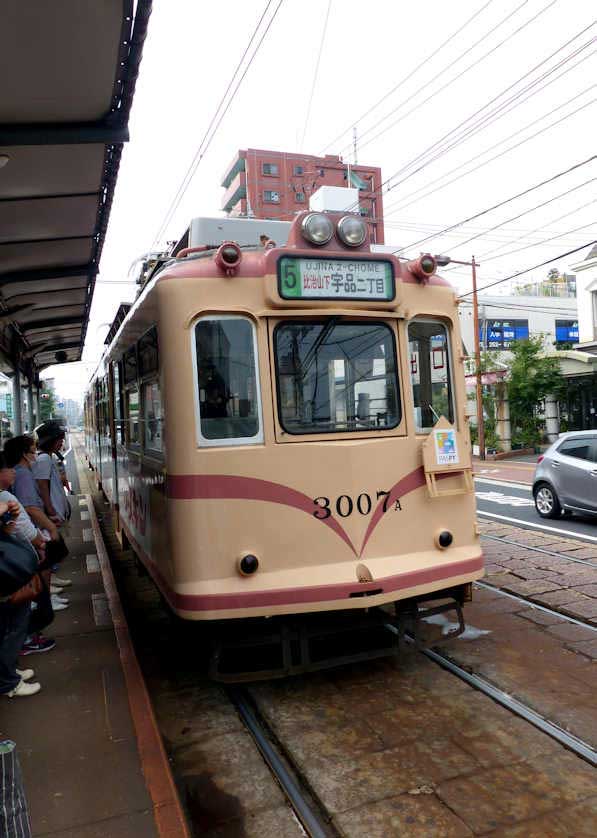
Hiroden trams in Hiroshima
Understanding Hiroshima's Tram Network: Lines, Routes, and Key Stations
Hiroshima's tram network is an extensive system that efficiently covers the city and its surroundings. The network consists of six inner-city lines with eight routes, covering a total of 19.0 km. Additionally, there's one railway line, the Miyajima Line, which extends for 16.1 km from Hiroden-nishi-hiroshima Station to Hiroden-miyajima-guchi Station.
Here's a breakdown of the main tram lines:
- Line 1 (Orange): Runs from Hiroshima Station to Hiroshima Port
- Line 2 (Red): Connects Hiroshima Station to Miyajima-guchi
- Line 3 (Blue): Operates between Nishi-Hiroshima Station and Hiroshima Port
- Line 5 (Green): Another route from Hiroshima Station to Hiroshima Port
- Line 6 (Yellow): Runs from Hiroshima Station to Eba
- Line 7 (Dark Green): Connects Yokogawa Station to Hiroden honsha-mae
- Line 8 (Pink): Operates between Yokogawa Station and Eba
- Line 9 (Gray): Runs from Hatchobori to Hakushima
Key terminal stations in the network include Hiroshima Station, Yokogawa Station, Miyajima-guchi Station, and Hiroshima Port Station. These stations serve as important interchange points, connecting the tram network with other forms of public transportation such as JR trains and ferries.
Hiroden Network Map © Hiroden
How to Use Hiroshima Trams: A Step-by-Step Guide for Visitors
Using Hiroshima's Trams is straightforward, but it might be different from what you're used to in other cities. Here's a step-by-step guide to help you navigate the system:
- Boarding the tram: Enter through the middle door. Unlike in some countries, you don't need to buy a ticket before boarding.
- During the ride: Take note of your destination. Station names are announced in both Japanese and English.
- Preparing to exit: When your stop is approaching, press the buzzer near the window to signal the driver.
- Exiting and paying: Exit through the front door (or rear door for multi-carriage trams). Pay your fare as you exit.
For payment, you have several options:
- Cash: Pay the exact fare in the box next to the driver. There's a change machine for large bills and coins.
- IC Cards: Use PASPY (the local IC card) or other compatible cards like ICOCA by tapping on the reader as you exit.
- Day Passes: Show your pass to the driver as you exit. Remember to scratch off the date on your pass before first use.
Remember, the flat fare within Hiroshima city limits is 220 yen for adults and 110 yen for children. Fares to Miyajima-guchi are slightly higher at 270 yen.
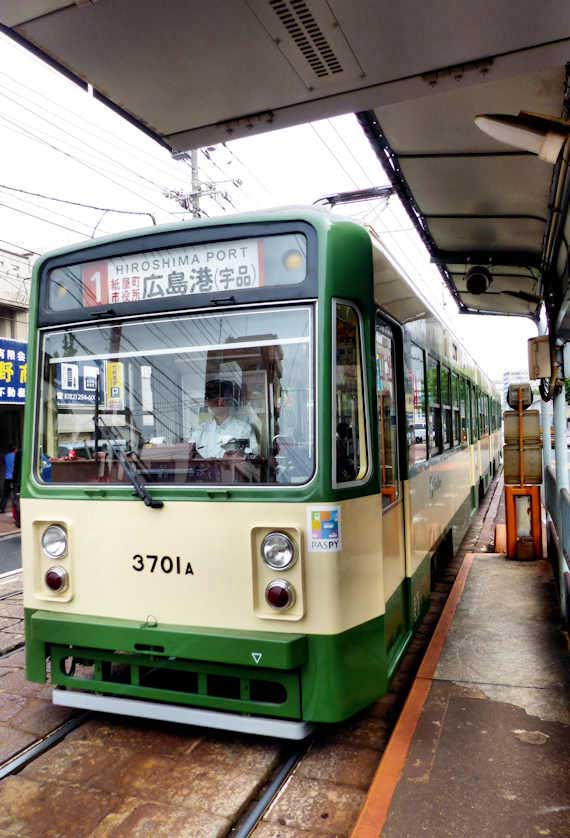
Hiroden tram to Hiroshima Port
Ticketing Options and Fare Information for Hiroshima Trams
Hiroshima's tram system offers various ticketing options to suit different travel needs:
- Single Ride: Pay as you go, with a flat rate of 220 yen for adults and 110 yen for children within the city.
- 1 Day Streetcar Pass: For 700 yen (350 yen for children), enjoy unlimited tram rides for a day.
- 1 Day Streetcar and Ferry Pass: At 1,000 yen (550 yen for children), this pass includes unlimited tram rides plus a round-trip ferry to Miyajima.
- Visit Hiroshima Tourist Pass: This pass offers unlimited travel on Hiroshima's transport systems for foreign visitors. Options include:
- Small Area Pass: Covers Hiroshima city and Miyajima (1,000 yen for 3 days)
- Wide Area Pass: Covers all of Hiroshima Prefecture (3,000 yen for 3 days)
For frequent users, the PASPY IC card is a convenient option. It's valid on all local transport and can be topped up as needed. Other IC cards like ICOCA are also accepted.
Remember, children under 6 travel free (up to three per accompanying adult). For groups of children, every fourth child pays the child fare.
Unique Features of Hiroshima's Tram Fleet: The Moving Streetcar Museum
One of the most fascinating aspects of Hiroshima's tram system is its diverse fleet, earning it the nickname "The Moving Streetcar Museum". The network operates over 270 trams from various eras and origins, including models from different parts of Japan and even some from Europe.
Notable features of the fleet include:
- Historic A-bombed trams: Two streetcars that survived the 1945 atomic bombing have been restored and continue to operate.
- Green Mover Max: This modern tram, introduced in 2004, was the first tram wholly built in Japan for Hiroshima's network.
- Piccola and Piccolo: These new "low-floor" trams, introduced in 2013, improve accessibility and connectivity.
- Vintage models: The fleet includes beautifully maintained trams from the early to mid-20th century, offering a nostalgic ride through history.
This eclectic mix of trams not only provides efficient transportation but also offers riders a unique journey through time, showcasing the evolution of tram technology and design over the past century.
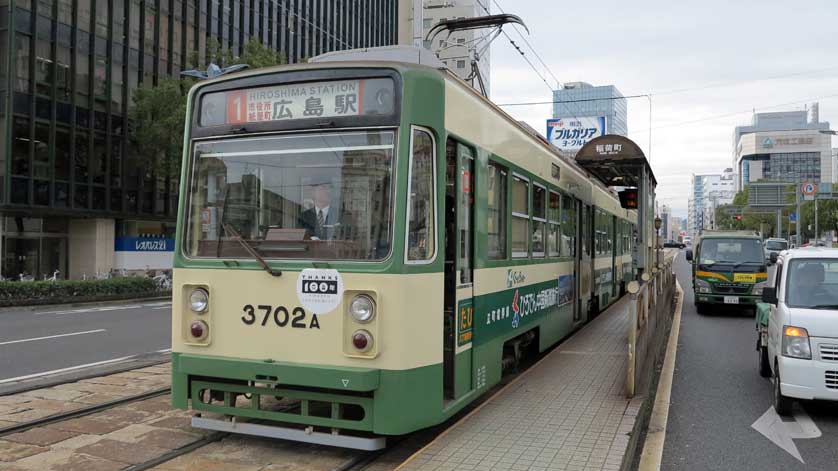
Hiroshima streetcar to Hiroshima Station
Connecting Hiroshima: Trams and Other Public Transportation Options
While the streetcar network in Japan is a central part of Hiroshima's public transportation system, it works in conjunction with other modes of transport to provide comprehensive coverage of the city and surrounding areas:
- Buses: Complement the tram network, reaching areas not served by streetcars. The Hiroshima Meipurupu (Maple Loop Bus) is particularly useful for tourists, connecting major sightseeing spots.
- JR Trains: For longer distances within the prefecture and connections to other cities.
- Ferries: Essential for reaching Miyajima and its famous torii gate. The streetcar line connects directly to the ferry terminal.
- Astram Line: A rapid transit system connecting downtown to the north-western suburbs.
For seamless travel across these different modes, consider the Visit Hiroshima Tourist Pass, which offers unlimited use of most public transportation in the area.
Tips for Making the Most of Your Hiroshima Tram Experience
To ensure you have the best experience using Hiroshima's trams, consider these helpful tips:
- Plan your route: Use the Hiroden Map to plan your journey. The network covers most major attractions including the Hiroshima Peace Park and Hiroshima Castle.
- Travel off-peak: Trams can get crowded during rush hours. If possible, plan your sightseeing during off-peak times.
- Try different trams: Each tram has its own character. Try riding different models for a unique experience.
- Visit the tram museum: For tram enthusiasts, don't miss Hiroshima's several fine museums, including one dedicated to the city's tram history.
- Use a day pass: If you plan to use the trams frequently, a day pass can save you money and the hassle of paying for each ride.
- Be respectful: Remember that while these are tourist attractions, they're also vital public transport for locals. Be considerate, especially during busy times.
Hiroshima's tram system is more than just a means of transportation; it's a journey through the city's history and a testament to its resilience. Whether you're visiting www.hiroden.co.jp for more information or stepping onto a historic streetcar, you're participating in a living piece of Hiroshima's heritage. Enjoy the ride and the unique perspective it offers on this remarkable city.
